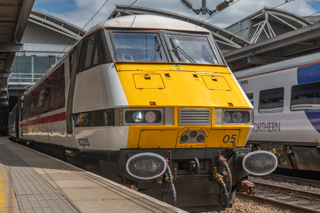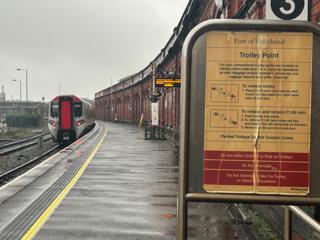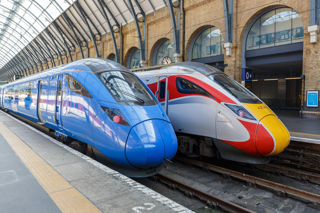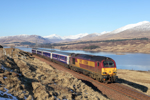Vivarail’s depot at Long Marston is not exactly a hive of activity. The work being carried out there is being done by just a handful of people in a couple of old sheds.
Yet the small team at Long Marston has already designed a train, installed almost everything needed to get it working, and is now in the process of re-installing several components and interior elements before the train can finally run outside the works fence.
Vivarail has a programme in place to introduce its D-Train test unit to public passenger use next year. As it stands, the test train is timetabled for testing on Network Rail’s Cotswolds line to Evesham at the end of November. The runs will be operated on behalf of Vivarail by GB Railfreight (RAIL 782).
This is a tight deadline, especially as expressions of interest in the new trains are coming thick and fast, according to Vivarail Chairman Adrian Shooter. Successful testing and final developments will almost certainly result in orders for them next year.
But despite the rapidly approaching deadline, everyone at Vivarail seems positive that things will go to plan. Shooter has no doubt that the test train will be completed in time for testing in November.
“We have a programme in place, and I see no reason why we shouldn’t meet that programme. Testing will begin at the end of November,” he tells RAIL.
The updates are also coming thick and fast. A new hybrid engine for 2016… testing to be carried out by GBRf in the Chilterns… the layouts and interior options are ready. Yet despite these progressions, the train isn’t ready. Why not?
“The gensets are still being tested in the Netherlands, otherwise it would have been ready this week,” says Shooter.
Testing the engines seems to be a little over cautious, bearing in mind that they have long been used in Ford Transit vans. But then everything on these trains is tested, re-tested, proven and then inspected. The refurbished bogies are completed by Strukton Rail in the Netherlands, and then installed at Long Marston. Incidentally, the works is currently little more than a refurbished old army locomotive shed.
The crash test footage RAIL is shown contains so much extra data and footage it could almost be made into a feature film. But the crashworthiness tests revealed that a reinforced cab structure designed and installed on site performed admirably. The impact test caused a 20mm deformation, whereas 120mm would have been the acceptable limit.
So, now that crashworthiness has been tested and the mechanical aspects are being finalised, what about the interiors?
“We can offer a basic interior, or an upgraded interior. It’s what the client wants,” says Design Manager Neil Bates (director of Creactive Design). “It’s modular. You can choose.”
The oft-spouted complaint that the D-Trains are already seen as unpopular London cast-offs is casually shrugged off by Vivarail. Shooter cheerfully says that “everything below the solebars is new”. Technically untrue, of course, because the bogies are not new but refurbished sets from the early 2000s onwards, but they’re certainly newer than the bodyshells.
In fact, after seeing all the options available, the image that the D-Train is simply Tube stock with new upholstery seems to be a massive oversimplification.
These trains are quite capable of being given an almost endless variety of customised interior features, from table seats to iPad holders. Folding bicycle spaces (designed specially for the ubiquitous Bromptons of London’s square mile) have been designed to allow further capacity solutions. A lack of toilets in the D-Train design is also apparently a myth. There is, in fact, a dedicated space within the trailing cars for toilet installation.
And the latest development is a buffet. Rather than a trolley service, the D-Train can now potentially have a small bar at one end, similar in design to the bistro car available on Amtrak’s Acela Express services in the US, or the second-deck buffets on France’s TGVs.
Even the moquettes and seat fillings are custom fitted. If a client wants a cheap and easy fix they can be given a firmer, cheaper filling, but a more luxurious padded seat is also available. The impression that is being drilled into visitors here is one of flexibility. It seems very much to be the case that the clients will design the trains with Vivarail’s help, not vice versa.
Vivarail’s plan has always been for the D-Train to be a cheap, quick alternative to expensive new-builds. The Japanese principle of ‘half the cost, half the speed, half the life’ is applied rigorously.
The D-Train is designed and intended to be cheaper - if a little slower - than a new or existing commuter or suburban DMU. It will never beat a Class 175 or a ‘Voyager’ for speed, but it’s not supposed to. It is supposed to outperform Pacers in the fuel consumption and comfort stakes. The engine has a good deal of torque, meaning the train will be well suited to accelerating quickly away from stations (a key feature on busy suburban lines). And the lower speed is irrelevant, considering their commuter target market.
Cost has proved to be something of a contentious issue. Vivarail has gone to great lengths to explain that it cannot provide a cost for the new production trains - instead, it all depends on the many choices that the client must make.
Will it cost more than a refurbished Class 144? Potentially. It all seems vague, and the rapid speed at which Vivarail produces ideas and reworks its creations suggests a lack of clarity of vision in the project’s initial aims. Further development seems to be happening before the bog-standard version has even been finished.
The trains themselves are being converted from D78 London Underground electric stock, and the conversion process for each car takes (at the moment) several weeks to a couple of months. The reason it’s currently so slow is because the project is still in the test stages. This isn’t a full-blown train production line - this is a toe in the water.
The bogies are stripped out for refurbishment and the motors removed. The Ford power units are modified for rail use by Revolve Technologies (Brentwood in Essex), while Strukton Rail works on the bogies and train management systems. The wiring and electrics are all stripped out and redone at Long Marston.
The advanced engine management systems in the D-Train (Class 230) means that it’s more efficient and more fuel-efficient than before. It also simplifies the driver’s job, and makes maintenance a lot easier than on the previous electro-mechanical systems.
The new engines are essentially held in place with friction, rather than being bolted in. Once again, this makes maintenance and removal easier.
On the test train, the bodyshells are barely altered. Door positions, windows and other parts can be moved or modified as per the future client’s specifications, but for now they still look like Tube trains. The famous image released of a D-Train’s front end with sloping angular lines is an ‘optional extra’ that Creactive Design has come up with.
However, the cab is rebuilt, with a lot of steel in there that wasn’t in it originally. The point of this is to create a ‘survival space’, so that in a collision a driver can walk away, rather than being trapped in his cab.
Technically, the D-Train is quite advanced for a small DEMU. It has stop-start engine technology to improve efficiency - a feature that is only now being applied to some Class 66s here and other locomotives abroad (RAIL 783). The potential for hybrid engines is also being investigated, which would make the D-Train the first production hybrid DMU in British history.
As it stands, the design is supposed to provide a decent fuel consumption of 0.5 litres per car per mile. (A Class 142 uses around 0.75 litres per car per mile.) This level of performance is something Vivarail is very keen to promote, and the promotional material calls it “the UK’s newest, greenest train”. Possibly a trifle misleading, considering the age of much of the structure of the units and the number of electric trains in the UK, but the intention is clear. These are supposed to replace older, less efficient and less comfortable stock that in the eyes of the public is very much life-expired.
Shooter was confident on the day of RAIL’s visit in mid-August that the test train would be ready in about one month. The men who are actually building the train, wiring up the cab and installing the cab controls seemed to think it would take a little longer. One engineer estimated it would be closer to the end of October.
The first driving car was all but complete. Wiring up for the main systems was ready, and the engines and bogies were in and ready, although the cab and carriage controls still needed to be populated. This includes the CCTV monitor for the cab, windscreen wipers, LED lights, door buttons and alarms for passengers, information displays and destination boards.
Although this is relatively quick and easy work, the other two cars still needed to have their engines, bogies and wiring finished.
Since RAIL’s visit, the driving car that was almost ready has now been internally gutted, ready for new interiors to be installed once again. This means it will not be complete until the end of November, potentially days - or even hours - before it’s due to go on test with GBRf. The front end of the cab will take approximately another six weeks to complete, according to Bates.
All that’s really left to do now is wait. Come November, we will see whether the D-Train test model is ready, and we will see if it successfully tests on the main line.
If it does, there may very well be a flood of eager train operators bidding for the new ‘crowdbusting’ cheap DEMU of the future. If not, Long Marston may be a much quieter place.
- This feature was published in RAIL 784 (September 30 - October 13 2015)















Andrewjgwilt1989 - 07/12/2015 03:52
Vivarail Class 230's DEMU's could be used in the North of England if it is possible or if not then they could be used in the Southwest of England and East of England working on rural lines that needs more trains and some of the Class 230's could be used on the rural lines in the East of England including Marks Tey-Sudbury branch line in Essex, Ipswich-Felixstowe branch line in Suffolk and Norwich-Sheringham via Cromer branch line in Norfolk to release the Class 153's and Class 156's to be used on EMT, Northern and GWR routes.